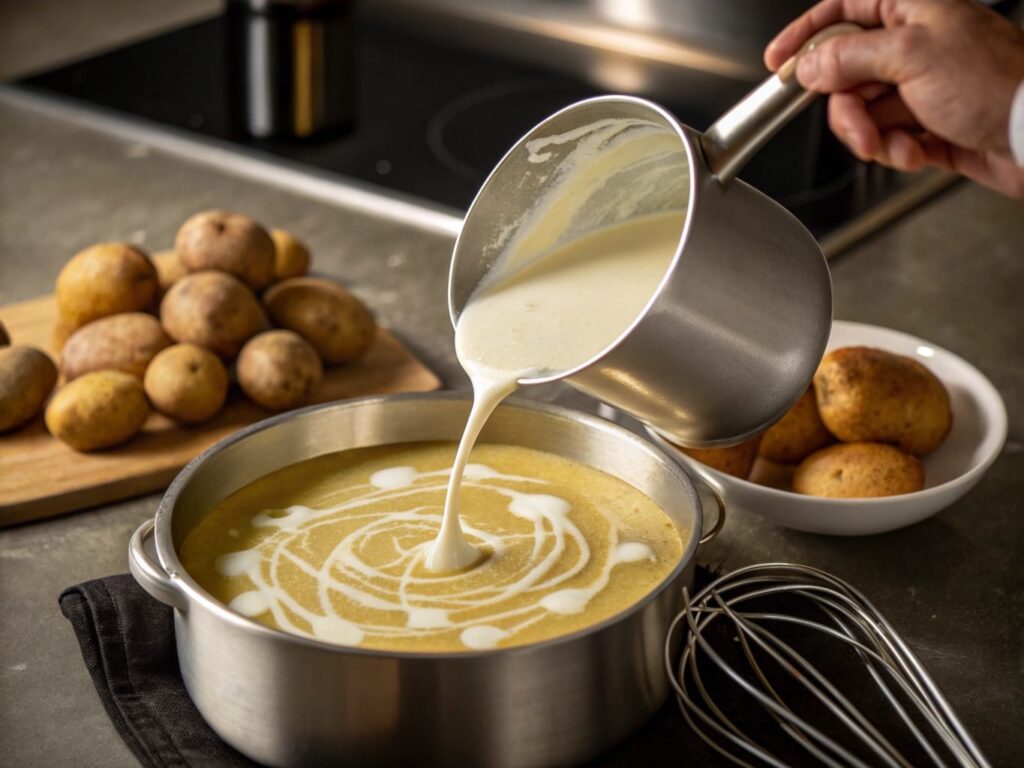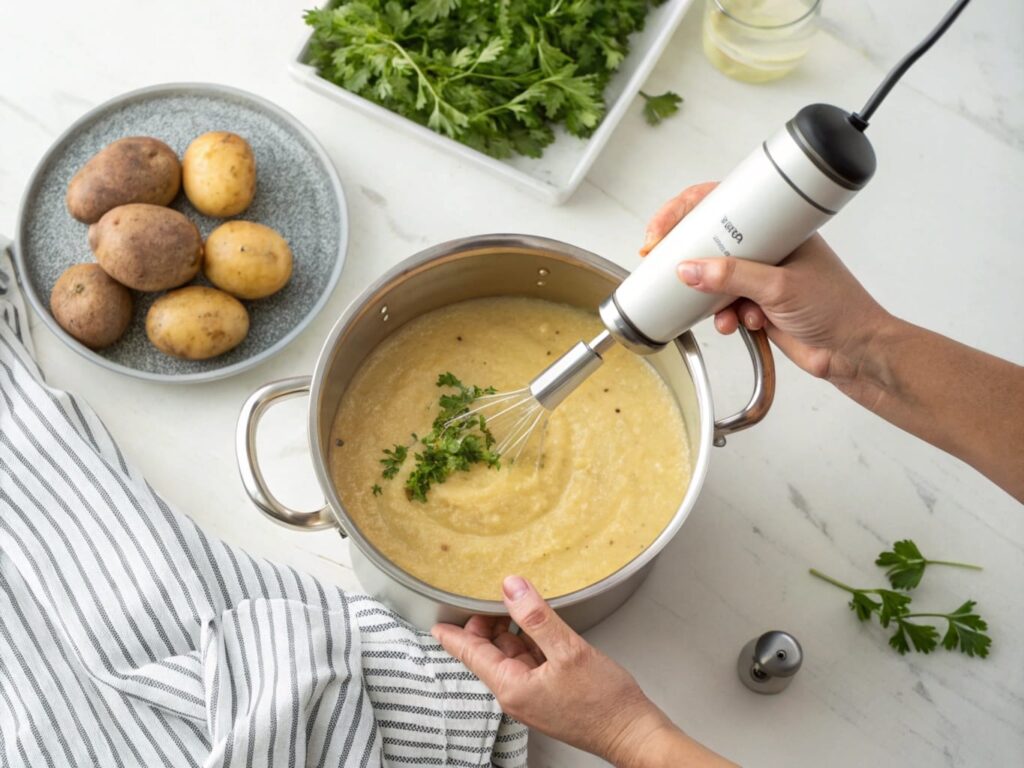Potato soup is the ultimate comfort food, but nothing is more disappointing than ending up with a bowl that’s far from creamy. From the choice of potatoes to cooking methods, several factors can turn your soup into a watery or gritty mess. In this guide, we’ll explore why your potato soup might not be creamy and provide actionable tips to fix and prevent this issue. Let’s dive in and make your next batch of soup irresistibly creamy!
Common Reasons Why Potato Soup Isn’t Creamy
Potato Selection Matters
The foundation of a creamy potato soup begins with choosing the right type of potato. Potatoes vary in starch content, and this can make or break your recipe.
- Best potato varieties for creamy soups: Russet potatoes and Yukon Gold are top choices. Their high starch content breaks down beautifully, giving you that silky texture.
- Avoiding starchy or watery potatoes: Waxy potatoes like red potatoes or fingerlings can be too firm, resulting in a chunkier consistency.
Cooking Techniques Affect Creaminess
Sometimes, the way you cook your soup can sabotage its texture.
- Overcooking or undercooking potatoes: Overcooked potatoes can turn gummy, while undercooked ones remain chunky and resistant to blending. Striking the right balance is key.
- Improper mashing or blending methods: Avoid using a food processor, as it can make the soup gluey. Instead, opt for an immersion blender or a hand masher for better control.
Inadequate Use of Dairy Products
Dairy is a game-changer when it comes to creamy soups, but it needs to be handled with care.
- Choosing the right cream or milk: Heavy cream or half-and-half are excellent options. Skim milk can water down the soup instead of thickening it.
- Why butter matters: Adding a touch of butter not only enhances flavor but also contributes to a richer, creamier consistency
Key Ingredients for a Creamy Potato Soup

The Role of Fatty Additives
One of the biggest reasons you might ask, “Why isn’t my potato soup creamy?” is the absence of rich, fatty ingredients. They work wonders in creating that luscious, velvety texture.
- Using heavy cream or full-fat alternatives: Heavy cream is the gold standard for creaminess. If you prefer alternatives, full-fat coconut milk or Greek yogurt can also work while adding a unique flavor.
- Enhancing with cream cheese or sour cream: Just a dollop of cream cheese or sour cream can transform your soup into a creamy masterpiece. They not only thicken the soup but also add a delightful tang.
Balancing the Starch Content
Potatoes naturally release starch, which helps thicken soups, but sometimes it’s not enough.
- The role of cornstarch and flour: A simple slurry made with cornstarch or all-purpose flour can do the trick if your soup lacks body. Whisk it into the soup slowly to avoid clumps.
- Using potato starch for consistency: Potato starch is a natural option that pairs perfectly with the main ingredient, keeping the flavor intact while boosting creaminess.
Flavor Enhancers for Texture
Sometimes, it’s not just about texture but also the added richness from complementary flavors.
- Incorporating cheese for creaminess: Cheddar, Gouda, or Parmesan can melt seamlessly into the soup, giving it both depth and creaminess.
- Using broths versus water: Substituting water with chicken or vegetable broth adds a savory base, enhancing the overall texture and taste.
Cooking Tips for Achieving Velvety Potato Soup
The Right Temperature and Timing
Cooking temperature and timing are crucial to prevent curdling or uneven textures in your soup.
- Slow cooking vs. pressure cooking methods: Slow cooking helps release potato starch gradually, yielding a creamier result. Pressure cookers are faster but require careful timing to avoid overcooking.
- Avoiding curdling of dairy: Always add cream or milk at the end, and avoid boiling the soup after adding dairy, as high heat can lead to curdling.
Using the Right Tools
The tools you use can significantly impact your soup’s texture.
- Benefits of immersion blenders: Immersion blenders allow you to control the blending process, letting you achieve just the right level of creaminess.
- Proper use of strainers for smoothness: For a silky finish, run your soup through a fine-mesh strainer to remove any lumps or fibrous bits.
Adjustments During Cooking
Not happy with how your soup’s turning out? Here’s how to fix it on the fly:
- Fixing thin soups: quick remedies: If your soup feels watery, add a quick roux, instant mashed potatoes, or a bit of cream to thicken it up.
- Avoiding lumps or uneven textures: Stir your soup regularly and add ingredients gradually to prevent any unwanted clumps.
Common Fixes for Non-Creamy Soup

Quick-Thickening Tricks
If you’re wondering, “Why isn’t my potato soup creamy?”, the answer might lie in how you thicken it. Thankfully, there are quick fixes to rescue a thin soup.
- Adding roux, cream, or instant potatoes: A roux (flour cooked in butter) can be stirred in for an instant texture boost. If time is short, a spoonful of instant mashed potatoes works wonders.
- Why simmering works: Allow your soup to simmer on low heat after adding a thickener. This ensures everything melds together beautifully, creating a creamy consistency.
Improving Texture After Cooking
Even if the soup’s finished, there are ways to fix its texture without starting over.
- Blending cooked soup for uniformity: Use an immersion blender to process a portion of the soup, leaving some chunks for texture. This will instantly thicken and smooth the broth.
- Adding a cream finish before serving: Stirring in heavy cream, sour cream, or even a bit of yogurt just before serving can elevate the texture and flavor to the next level.
Preventing Common Mistakes in Potato Soup Recipes
Choosing the Right Ingredients from the Start
One key reason you might ask, “Why isn’t my potato soup creamy?” is poor ingredient selection. Starting with the right components ensures your soup turns out just right.
- Prioritizing high-starch potatoes: Starchy varieties like Russet or Yukon Gold potatoes naturally break down during cooking, creating a creamy base. Avoid waxy potatoes, as they stay too firm.
- Using fresh and quality ingredients: Fresh dairy products, like heavy cream or whole milk, make a big difference. Avoid substitutes like low-fat milk unless paired with thickening agents.
Cooking Techniques to Avoid
Even with the best ingredients, the wrong technique can leave your soup lumpy, thin, or gritty.
- Over-blending or under-blending: Overuse of high-powered blenders can make your soup gummy due to over-released starch. Conversely, under-blending leaves uneven chunks.
- Skipping the roux or thickening step: Forgetting to thicken the base during cooking can result in a soup that’s too watery. Always incorporate a thickening agent when needed.
Frequently Asked Questions
Why is my potato soup too watery?
A watery potato soup might be the result of using the wrong potatoes or too much liquid. Russet potatoes work best for thick soups, while over-reliance on broth or water can dilute the consistency. Adding starches or reducing the soup through simmering can help.
What are the best substitutes for cream in potato soup?
If you don’t have cream, try full-fat coconut milk, cream cheese, or even Greek yogurt. These alternatives still provide a rich texture while adding their unique flavors.
Can I fix my soup after it’s done?
Absolutely! Whether you blend it, add a thickener, or stir in some cream, there’s always a way to rescue a finished soup. Don’t forget, seasoning it correctly can also enhance its taste and feel.
Suggestion for Readers
For more delicious soup recipes and tips, check out our article on How to Improve Bland Potato Soup.
Creative Additions for Extra Creaminess and Flavor
Elevating Creaminess with Unique Ingredients
If you’re still wondering, “Why isn’t my potato soup creamy?”, consider adding some unexpected elements that boost texture and flavor.
- Incorporating mashed potatoes: Using leftover mashed potatoes as a thickener is both resourceful and effective. Stir them in to add creaminess instantly.
- Adding cheese for richness: Soft, melting cheeses like cheddar, Gouda, or cream cheese integrate smoothly, enhancing both creaminess and taste.
Enhancing Flavor Without Overpowering the Base
A creamy soup is only as good as its flavor. These additions can amplify taste without altering the creamy texture.
- Mixing in sautéed aromatics: Sautéed onions, garlic, or leeks can add depth and warmth to your soup without changing its smooth consistency.
- Topping with garnishes: Garnish with fresh herbs like parsley or chives for a pop of color and freshness, balancing the creaminess.

